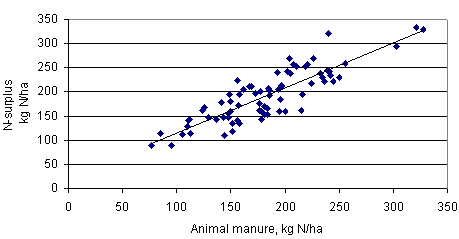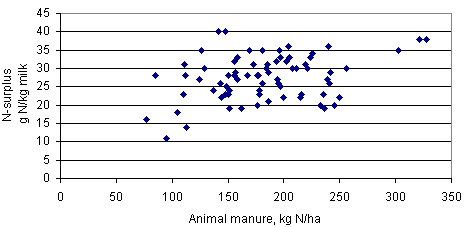|
Produktorienteret miljøindsats i landbrugets primærproduktion English summaryA product perspective on environmental issues can also benefit the agricultural economy There is a potential for both reducing the environmental effect of agriculture and improving the efficiency of agriculture, by including the environmental effect per unit of production (i.e. per tonne of wheat, per tonne of pork, etc.) as a supplement to the traditional environmental effect per unit of area or per farm unit. Among the measures that can be applied in a product-oriented environmental policy, there is most acceptance of and largest potential in the market-oriented measures (e.g. differentiating agricultural subsidies according to environmental performance). In comparison to these measures, it will require disproportionately large investments to increase the demand for food products with a documented low environmental effect, e.g. through a labelling and certification scheme. These are some of the important conclusions from the project "Product-oriented environmental policy for agricultural production" which has analysed a number of ways and means to implement product-oriented environmental policies in Danish agriculture. Product orientation is a relatively new concept in the environmental policy, introduced in Denmark through a government publication in 1995 and in EU through the "Green Paper on an Integrated Product Policy" of February 2001. In a product-oriented environmental effort/policy, the focus is moved from the individual environmental effects to the overall efficiency of the processes and interactions that cause the environmental effects. One of the important advantages of a product-oriented perspective is that the various environmental effects are seen in combination, so that a specific preventive measure does not introduce new problems elsewhere. Thus, the product-oriented perspective becomes a useful tool for supporting decisions that reduce the environment impact. Recording the environmental effects per unit of production may also facilitate a more flexible public regulation with a larger degree of freedom for the farmer to choose appropriate methods. Until now, environmental regulation of Danish agriculture has not been product-oriented but rather been related to area management (e.g. regulation of the number of livestock per hectare, particularly environmentally sensitive areas and the like) and directed towards specific problematic substances (such as nutrients and pesticides). However, there are good reasons to believe that the product-oriented environmental policy will also be of importance for agriculture because it is more comprehensive and focused upon the overall environmental effect and therefore potentially more effective with respect to the general environmental goals. Still, there will remain some environmental aspects that require a more geographically specific or source-oriented regulation. If we take a traditional, area-based view on the environmental effect from nitrogen (expressed as nitrogen-surplus, see figure 1), we find a strong positive correlation with the animal density. This points to one obvious way of reducing the effect, namely the economically very unattractive option of reducing the animal density and thus the production per area. If we instead look at the nitrogen-surplus per unit of product (figure 2), we find a very large variation and thereby a large potential for both a reduction in environmental effect and an efficiency improvement (because the nitrogen-surplus is a function of the fodder efficiency as well as of the production per hectare and the production per nitrogen input). Thus, a reduction in environmental effect can go hand in hand with the economic interest of the farmers.
Figure 1.
Figure 2. Similarly, a product-oriented approach to pesticide regulation will be directed towards the actual expected environmental effect of the pesticide treatments, expressed in toxicity-equivalents per unit of yield. This should be seen in comparison to the current indirect approach, which is based on the intensity of treatment (i.e. the number of standard applications) and a pesticide levy unrelated to the environmental effect but only related to the price of the pesticide. A product-oriented approach will aim at giving the individual farmer better planning and decision tools, enabling comparisons of the environmental effect of different pesticide treatments, also seen in relation to the expected additional yield and in relation to potential alternative mechanical and biological treatment methods. However, the full effect of the product-oriented approach will only be achieved if also the pesticide levies are differentiated according to environmental effect. As these examples illustrate, there is new understanding to be gained both for the individual farmer and for agriculture as a whole, when the environmental effect is expressed per unit of product and compared to standard values. This could directly or indirectly influence the behaviour of the farmers to the benefit of the environment. The basic prerequisite for a product-oriented approach is that the environmental effect can be recorded per unit of product, that is per tonne of wheat, per kg of pork, per 1000 kg of milk, etc. To enable this, we propose that the existing PC tools "Grønt Regnskab" (to produce "green accounts") and "Bedriftsløsning" (for use in farm planning) be extended such that the present records per farm unit can be related to the amount of each product from the farm. In addition, it shall be possible to convert the records to more direct expressions of the environmental effect (such as evaporation of ammonia or leaching of nitrate) and to extend the records to include the environmental effect from the production of materials imported to the farm (such as fodder and fertiliser) and other external processes that are influenced by decisions and activities on the individual farm (such as bio-gasification of liquid manure in central plants). The records per unit of product on the individual farm can be used internally among farmers (to make comparisons and as a basis for suggesting improvements) and externally in the dialogue with other actors or interested parties, including public authorities. Also the food industry can use the records, incorporating them into corresponding records per unit of manufactured product (per kg sausage, per kg cheese, etc.) for use e.g. in marketing. As an example, the Danish pork producers have a future goal of "being able to inform the customers of the total environmental effect from farm to table" ("Svinesektoren på vej mod nye mål", September 2001). Although the records are generally regarded as a valuable tool internally on the farms, we only expect that a small number of farmers will use them, unless provided with additional incentives or demands. Among the farmers, it is a clearly expressed expectation that the effort should result in an improved sales price or other economic advantages. However, compared to other measures, it will require disproportionately large investments to increase the demand for foods with a documented low environmental effect, and this is therefore not recommended as a general strategy. One exception to this is the Danish market for public procurement, which can be affected with a relatively smaller effort than other markets. It is also worth considering whether a Danish "systems export" in the agro-environmental area could contribute to a larger consumer awareness on the local markets and thereby indirectly create new markets for Danish products. We assess that it will be difficult to successfully supplement the existing labelling scheme for ecological foods with another labelling scheme for the environmental properties of foods. Rather, it is to be expected that over time the concept for the government supervised ecological label will be developed further to include life cycle aspects and more comprehensive environmental documentation as it is known from the two government approved eco-labels, the Nordic "Swan" and the EU "Flower", and correspondingly that a larger share of the total agricultural production will be eligible for labelling. As an alternative to eco-labelling, we can point to a tendency in connection to the "branding" of supermarket chains, that specific requirements are made on products and production methods. Such "branding" could also be initiated by important actors in the food industry, possibly coordinated via the Danish Agricultural Council. The agricultural organisations attach importance to securing a coordinated profiling of Danish agriculture by letting the rules and an impartial certification of these be established and organised by the agricultural industry itself or its sub-sectors. Those measures, which conceivably could be used to directly encourage farmers to think in terms of environmental effect per product, range from market-oriented measures (such as levies and subsidies) over product standards and quotas to detailed regulation, the latter currently being the most prevalent. All the actors interviewed in this study have expressed a clear preference for the market-oriented measures. Even the representatives from agriculture were quite open towards levies, provided these be imposed directly on the environmental effect and the proceeds be channelled back to agriculture. This would correspond to a differentiation of the agricultural subsidies according to environmental effect. Such a differentiation would obviously be a strong motivator for reducing the environmental effect per product. It is important that the regulative measures be designed such that all farms can benefit from reducing their environmental effect. This calls for using a continuous (step-free) regulation model rather than one with levels, where only performance above a certain level is rewarded or performance below a certain level is penalized. For the agricultural sector, it is important that any prospective environmental levies and subsidies be designed to be economically neutral to the sector as a whole. This is one of the reasons why some farmers express a preference for letting agriculture handle these matters internally as far as possible. This could perhaps be obtained through a differentiation of prices according to the environmental effect of the product. This would imply the involvement of the food industry in a voluntary arrangement, where a higher price is paid for products with a relatively low environmental effect and a lower price is paid for products with a relatively high environmental effect. There is, however, not unanimous support among farmers for a self-organized price differentiation as an alternative to public levies. But we have found support for an idea to make the food industry (i.e. especially dairies and slaughterhouses) pay a premium for the documentation alone, regardless of the current environmental performance of the individual product. This could encourage the use of the proposed product-oriented tools, and it would establish a broader foundation for possible further initiatives.
|

